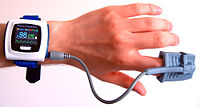
Photo from wikipedia
The pulse oximeter is a ubiquitous clinical tool used to estimate blood oxygen levels. However, decreased accuracy of pulse oximetry in patients with dark skin tones has been demonstrated since… Click to show full abstract
The pulse oximeter is a ubiquitous clinical tool used to estimate blood oxygen levels. However, decreased accuracy of pulse oximetry in patients with dark skin tones has been demonstrated since as early as 1985. Most commonly, pulse oximeters may overestimate the true oxygen saturation in individuals with dark skin tones, leading to higher rates of occult hypoxemia (i.e. clinically unrecognized low blood oxygen saturation). Overestimation of oxygen saturation in patients with dark skin tones has serious clinical implications, as these patients may receive insufficiently rigorous medical care when pulse oximeter measurements suggest that their oxygen saturation is higher than the true value. Recent studies have linked pulse oximeter inaccuracy to worse clinical outcomes, suggesting that pulse oximeter inaccuracy contributes to known racial health disparities. The magnitude of device inaccuracy varies by pulse oximeter manufacturer, sensor type, and arterial oxygen saturation. The underlying reasons for decreased pulse oximeter accuracy for individuals with dark skin tones may be related to failure to control for increased absorption of red light by melanin during device development and insufficient inclusion of individuals with dark skin tones during device calibration. Inadequate regulatory standards for device approval may also play a role in decreased accuracy. Awareness of potential pulse oximeter limitations is an important step for providers, and may encourage consideration of additional clinical information for management decisions. Ultimately, stricter regulatory requirements for oximeter approval and increased manufacturer transparency regarding device performance are required to mitigate this racial bias.
Journal Title: Annals of the American Thoracic Society
Year Published: 2022
Link to full text (if available)
Share on Social Media: Sign Up to like & get
recommendations!